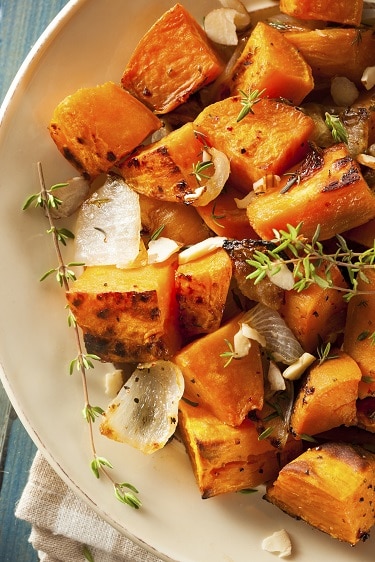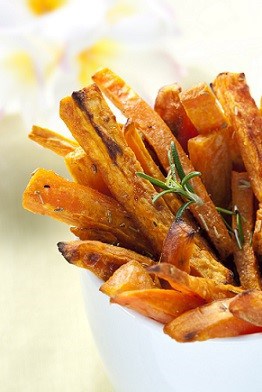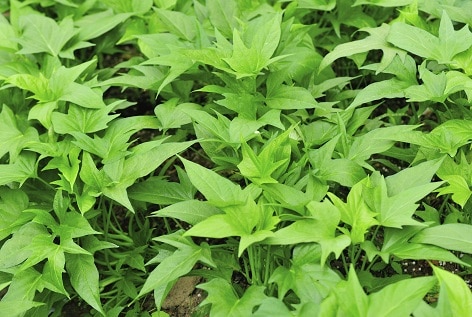 Sweet potatoes have been eaten since the early 16th century. Christopher Columbus brought them to Spain after his first New World voyage in 1492. From there they travelled to Italy and then to Austria, France, England, and Germany, where they became a beloved delicacy.
Sweet potatoes have been eaten since the early 16th century. Christopher Columbus brought them to Spain after his first New World voyage in 1492. From there they travelled to Italy and then to Austria, France, England, and Germany, where they became a beloved delicacy.
There’s over 400 varieties, but almost all are extremely healthy. The sweet potato was the first food early English settlers in the US ate en masse, as they discovered native Incan races cultivating them and quickly followed suit. Sweet potatoes alone kept many American communities from starving and fizzling out.
There’s one power of sweet potatoes might be of interest to you…
…and that’s their strong power to clear your acne.
The best energy source for an acne-clearing enthusiast
Firstly, the sweet potato is the most nutritious and least problematic carbohydrate source for acne available.
To get acne-proof skin you need at least 120 grams of carbs a day; you need energy for exercise to keep your bodily systems efficient. Carbohydrates also manufacture the happiness hormone serotonin, which keeps acne-causing stress at bay.
Read Annihilate Your Acne – get the ultimate diet for clear and glowing skin!
200g of sweet potatoes delivers 40 carbs, but also tons of micronutrients:
566% of the RDA for vitamin A – this acne nutrient controls your sebum production and can thus prevent blocked pores. Vitamin A also reduces your production of keratin, the protein that clumps your dead skin cells together into pore-blocking, acne causing blobs.
The outstanding vitamin A content is evident in the plant’s intense orange colour. Beta carotene, the form of pro-vitamin A in sweet potatoes, provides yellow, red and orange hues to plants (like pumpkins and carrots), and sweet potatoes are the most orange food in the business.
66% for vitamin C – important for the production of collagen, your skin’s main structural protein that helps your dying acne to fade away faster. Also useful for clearing excess stress hormone levels from the bloodstream.
50% for manganese – a much ignored acne nutrient that your body uses to manufacture antioxidants like glutathione and thioredoxin reductase. They keep your skin strong and even regenerate other vitamins once they’ve been used, like vitamin E and C.
Manganese is another one that aids collagen formation. Additionally, manganese is a cofactor required for the absorption of vitamin E, the most important acne nutrient ever.
14% for magnesium – another acne mineral that helps to create antioxidants. Magnesium also reduces stress and can beat sleep deprivation; it’s so effective that the media widely hails magnesium as the “relaxation mineral”. Deficiency in magnesium is at epidemic levels.
An ORAC score of 4230 – this means that sweet potatoes are packed with antioxidants, which protect your skin against acne from harsh elements like chlorine and air pollution. A white potato has a good ORAC score too but it’s substantially lower nevertheless, at 2600.
Important article – the top 6 vitamins and minerals for clearing acne
A slice of whole grain bread contains few acne nutrients; no vitamin A, vitamin E nor antioxidants. Bread does have magnesium but it’s bound up with phosphorous molecules that the human gut cannot digest. Worse, any wheat-based carb source is an acne-spreading bombshell of highly inflammatory gluten. You could eat oatmeal, but oats are full of lectins, defensive plant weapons which cause acne by punching holes in your digestive tract.
Sweet potatoes meanwhile are as clean a food for acne as one could ever hope to stumble across. They do contain 6 grams of sugar per 100 grams but the nasty consequences of sugar like acne and inflammation only kick in with large intakes. Depending on what acne nutrients you’re short of, sweet potatoes may even trump white ones since their vitamin A content dwarfs the competition.
That’s not all either. Here are some other acne-clearing benefits of sweet potatoes…
Sweet potatoes increase insulin sensitivity
Insulin resistance is one of the worst conditions ever for acne because it elevates serum insulin levels and stimulates your sebaceous glands to produce more oil. Insulin is the single strongest acne hormone and sweet potatoes are terrific at controlling it.
Important article – the top 7 natural topical treatments for acne
Adiponectin is a protein hormone which is an important regular of insulin metabolism. Evidence shows that patients with insulin resistance and dysfunctional insulin metabolism tend to have low levels of adiponectin, whereas people with healthy insulin levels have more.
Why is this relevant? Well, sweet potatoes have been shown to strongly boost production of adiponectin in patients with type 2 diabetes. There’s plenty of evidence elsewhere too:
In this Japanese study from 2013, scientists took 24 rats who had developed diabetes after being assigned a high-fructose diet, and fed them sweet potato starch for 4 weeks. 16 healthy rats were also studied as a control. Some rats were also fed regular potato starch to make a comparison.
The scientists found that sweet potato starch boosted the function of insulin receptors, meaning that significantly less insulin was required to shuttle energy into them efficiently.
Significantly less insulin is another way of saying significantly less acne. The scientists concluded: “Our results illustrated that sweet potato starch feeding for 4 wk can improve insulin sensitivity in insulin-resistant rats, possibly by improving the adipocytokine levels… and insulin signalling.”
That’s great news for acne patients. Sweet potatoes are actually feared by many diabetics, because they are high in starch with a glycaemic index of medium. Sweet potatoes digest into glucose and trigger a faster increase in blood sugar and insulin.
Read the eBook: learn why common vegetable oils are an acne nightmare
However, while sweet potatoes increase insulin in the short term, they also boost the functioning of the insulin receptors in your glycogen stores thanks to their varied phytonutrients, which allows long-term insulin to fall. For treating acne, long term or fasting insulin levels are far more important than the size of temporary spikes.
Therefore, sweet potatoes can make your skin less oily, your skin pores less clogged, and p.acnes bacteria less prominent.
Sweet potatoes lower inflammation levels
Chronic inflammation is one of the two biggest causes behind acne, as it causes your immune system to bombard acne causing bacteria with too much force and swell up the surrounding tissue…
…and sweet potatoes can inhibit several of the chemicals responsible. NF-KappaB is a master molecule that stimulates the release of many pro-inflammatory chemicals behind acne. According to studies on purple sweet potatoes, one of the 400 different subspecies, they can lower NF-KappaB significantly. Therefore they can also inhibit production of interleukin-6, TNF-a, neutrophils and all sorts of other vicious chemicals.
Another “master chemical” is COX-2. This chemical is so potent at inflaming your tissues and inflaming your acne that to treat arthritis many diseases doctors specifically target it with pharmaceutical non-steroidal anti-inflammatory drugs. Aspirin and ibuprofen exert their wonderful effects like joint pain relief precisely by inhibiting COX-2.
Sea buckthorn oil – a topical treatment which lowers oily skin by 45%
It seems sweet potatoes could put aspirin companies out of business. One specific class of antioxidants called flavanols has been shown to inhibit COX-2, and large portion of the sweet potato’s sizeable antioxidant count comes from flavanols.
Studies reveal that sweet potatoes can inhibit all manner of inflammatory actors:
STUDY ONE – this study found that an extract of purple sweet potatoes fed to rats with liver damage significantly inhibited COX-2. It also inhibited NF-KappaB. Additionally, the purple sweet potatoes increased levels of antioxidants significantly including quinine oxidoreductase-1, heme oxygenase-1, and GSTα. So sweet potatoes contain their own acne-clearing antioxidants, and they boost the activity of those made your body.
STUDY TWO – this study applied a trypsin inhibitor extracted from sweet potato to mice paws, which had been badly inflamed. Concentrations of inflammatory chemicals like tumour necrosis factor-alpha (TNF-a) fell, as did thiobarbituric acid reactive substances, a family of free radicals.
STUDY THREE – the Japanese study on insulin resistance discussed above also found that sweet potato starch reduced many inflammatory chemicals. These included tumour necrosis factor-α and interleukin-6, which acne patients have in higher amounts. Furthermore, sweet potato starch had stronger anti-inflammatory powers than regular potato starch.
What does this mean in the real world? That sweet potatoes have the power to calm down your red and inflamed acne.
With daily consumption, your entire immune system will be less active, less p.acnes bacteria will be bombarded, and acne will be prevented from forming in the first place.
How sweet potatoes actually reduce chronic inflammation is unknown, but the sheer concentration of vitamin A might have something to do with it. Sweet potatoes are a complex food, with proanthocyanins, phenols, and carotenoids galore; any compound could be responsible.
Sweet potatoes improve digestion
 One of these phytonutrients is the famous quercetin, a water soluble antioxidant that belongs to the flavanol family.
One of these phytonutrients is the famous quercetin, a water soluble antioxidant that belongs to the flavanol family.
Quercetin is terrific at combatting food allergies. Bad reactions to foods as varied as apples and eggs are often caused by over activity of immune system mast cells. They fire too many inflammatory chemicals at random foods, regardless of whether they’re a threat or not.
Raw honey – a natural secret for wiping out acne bacteria
Actors like histamine then flood your bloodstream, swelling your throat up and making your eyes water. One of the most frequently reported symptoms of an allergic reaction is acne.
Why’s this important for your acne? Because ever more studies are finding that quercetin can keep these overeager mast cells on a leash. Quercetin directly combats the acne-triggering effects of histamine and other inflammatory chemicals. According to one study, quercetin is more effective at inhibiting mast cell activity than the pharmaceutical drug cromolyn, which is used as a nasal spray to treat asthma…
…and it so happens that sweet potatoes are packed full of quercetin. You can also find quercetin in apples, bananas, onions, and other acne-friendly plant foods, but among carbohydrate rich foods sweet potatoes are one of the best sources.
As so often occurs in nutrition, sweet potatoes easily beat drugs with millions of dollars’ worth of research poured into them when it comes to tackling inflammation and acne.
Are sweet potatoes a top-notch food?
For an acne patient they are superb. Sweet potatoes are great if you’re an acne patient with very oily skin, because of the vitamin A. Everyone with acne can benefit from a vegetable that’s bursting at the seams with antioxidants.
Then there’s the delicious caramel-like flavour, and the sheer convenience. I eat 400 grams of sweet potatoes every other day. All I do is slice them into wedges and roast them in the oven for 40 minutes on 190c. This creates a culinary masterpiece with less effort than breathing. I tried roasting sweet potatoes in olive oil once, but all that happened was that they became soggy.
However, it is a smart idea to eat some fat with the meal. According to one widely reported study, eating beta-carotene from tomatoes (the form of pro-vitamin A found in sweet potatoes) alongside just 3-5 grams of a fatty food like avocado boosted its absorption in the digestive tract 2.4 fold. Furthermore, the conversion of beta-carotene to vitamin A was enhanced 4.8 fold.
Why vitamin C is the acne nutrient you cannot ignore
While I don’t believe that sweet potatoes taste good when mixed with oils, you should eat them in a meal alongside some cheese, a piece of steak, or even some chocolate (which doesn’t actually cause acne), or any other acne-friendly food with a decent fat content. Even downing a tablespoon of coconut oil out of the blue will make a massive difference.
Only 3-5 grams of fat is required. This study compared beef tallow (a saturated fat) and sunflower oil (a polyunsaturated fat) and found that the beef fat improved beta-carotene absorption in female test subjects far more, so skip the vegetable oils. They’re a nightmare for acne anyway.
Organic vs non-organic
What’s also great about sweet potatoes is that you don’t have to spend your hard earned cash on the organic version. Every year, the Environmental Working Group compiles a list of 15 fruits and vegetables with the lowest agrochemical contamination, known as the “clean fifteen”. The positions jump up and down from year to year but sweet potatoes nearly always get a place.
Bugs sometimes eat the leaves of sweet potatoes, but because that hardly affects the quality of the underground tubers which people actually eat, farmers generally don’t believe it’s worth protecting the leaves with pesticides.
However, after harvesting sweet potatoes commonly have a problem with fungal growth. Hence, farmers often give the tubers a quick dunk in a dicloran bath before being packed and shipped, to kill it off. Dicloran is a chemical fungicide that according to the “What’s on my food” website (a useful library of the agrochemical contamination of many commercial products) is a “possible carcinogen”. From the many studies I’ve looked at on environmental chemicals, many carcinogens tend to trigger acne via inflammation and acne via oxidative stress.
Luckily, dicloran is the only pesticide that is consistently detected in conventional sweet potatoes. On average, one kilogram of regular sweet potatoes contains 1.69 mg of dicloran. Toxicology studies suggest a dicloran safe upper limit of 0.14 mg per kilogram of bodyweight, so a 60 kilogram human being can consume up to 8.4 mg of dicloran with no extra risk of acne.
Furthermore, sweet potatoes taste far better when peeled, which eliminates even more acne-causing chemicals. Sweet potatoes are dunked in the dicloran bath after they are fully grown, so most of the inflammatory pesticides are concentrated in the skin.
Therefore, sweet potatoes are an excellent source of acne-friendly nutrition if you’re low on cash.
Health benefits of sweet potatoes
 By getting your carbs from sweet potatoes, your entire body will become healthier:
By getting your carbs from sweet potatoes, your entire body will become healthier:
Cancer prevention – as we discussed earlier, the pro-vitamin A carotenoids in sweet potatoes have to be converted in your digestive tract before they work. Well, those carotenoids have good benefits before they get converted too.
One study conducted by researchers at Women’s Healthy Eating and Living (WHEL) followed women who had completed treatment for early stage breast cancer, and found that women with the highest blood concentrations of carotenoids had the least likelihood of cancer recurrence.
Green tea – proven to reduce acne by up to 51% after eight weeks!
Another study by Harvard University on more than 124,000 people found that people who consumed a variety of carotenoid-rich foods as part of their daily diet enjoyed a 32 percent reduction in the risk of lung cancer.
Eye protection – carotenoids also boost your eyesight. Sweet potatoes are packed with lutein, which is famous for protecting cells in the cornea of your eye from oxidative stress. In England in 1939, there was a big campaign by the wartime government to get citizens eating carrots (packed with carotenoids), so that they didn’t start falling into ditches and getting run over when the night-time blackout came into force.
Scientists in one study questioned 4,519 people aged 60 to 80 about their dietary habits over a period of six years. People in the top 20% in the lutein consumption ranks had a 35 percent lower risk of developing age-related macular degeneration (AMD) than those ranked in the bottom fifth. AMD is the biggest cause of blindness in old people.
Lutein builds up in the cells of the cornea of your eye, strengthening them against oxidative damage from sunlight and pollution. Elderly folks suffering from macular degeneration are actually prescribed lutein supplements.
There’s no need, not when sweet potatoes have enough to prevent blindness. They’ll even enhance your eyesight at night. Then once the carotenoids convert to vitamin A, necessary for, you’ll have the vision of a hawk.
As we discussed, I eat a 400 gram serving of sweet potatoes (roughly 14oz) serving every two days. But you can consume enough of the nutrients to benefit from just 80 grams, one moderate sized potato.
The ideal quantity depends on how many carbohydrates you need, and how many other vegetables you eat. But you scarcely have to restrict yourself as long as your carbohydrate intake is low elsewhere.
Conclusion
Sweet potatoes are the nutritional equal of any fruit or vegetable for acne, even “superfoods” like broccoli and blueberries.
I’m sure you’ll have heard the whole “5-a-day” strategy that schoolteachers relentlessly insist upon. Well, that’s a very good strategy for acne. You need to feed your body a variety of nutrition to give your skin the best possible chance. Sweet potatoes are a tasty and convenient food for doing that.
For the easiest reduction in acne, you should replace a wheat-based food like pasta, bread or cereal with sweet potatoes. You’ll get rid of a bunch of inflammatory gluten (a nightmare for acne) and lectins and pump your body with nutrition in one fell swoop.
NEXT: learn the root causes of acne, clear your skin permanently
Thanks for reading!